Modular: Using Norse-Themed Roleplaying Games and Supplements to Expand the World of Yggdrasill — Vidar Solaas’s Vikings RPG
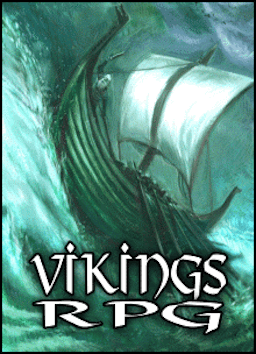 Some time ago I celebrated the new Modular series of Black Gate posts by contributing my own enthusiastic review of the four English-language volumes in the current Yggdrasill roleplaying game line. I’m grateful for the many responses to that post and for the reader recommendations of other Norse-related rpg material. I would collect all roleplaying game materials, regardless of game ethos or genre, but my budget won’t allow it. So I’ve narrowed my collection to Norse and Viking-themed materials. Hey, I tell myself, I’m actually running a Viking-themed game right now, using Yggdrasill, and I can justify this expense by believing, truthfully or not, that I’ll find some practical gaming use for it.
Some time ago I celebrated the new Modular series of Black Gate posts by contributing my own enthusiastic review of the four English-language volumes in the current Yggdrasill roleplaying game line. I’m grateful for the many responses to that post and for the reader recommendations of other Norse-related rpg material. I would collect all roleplaying game materials, regardless of game ethos or genre, but my budget won’t allow it. So I’ve narrowed my collection to Norse and Viking-themed materials. Hey, I tell myself, I’m actually running a Viking-themed game right now, using Yggdrasill, and I can justify this expense by believing, truthfully or not, that I’ll find some practical gaming use for it.
As I collect these materials, I notice that they sort into three or four categories:
- Actual “full” roleplaying games; what I mean here is that the product comes complete with rules and setting designed to emulate, in particular, the kinds of experiences one expects from a Norse-themed roleplaying game
- Sourcebooks and campaign settings, using the real world “Viking Age” as inspiration but designed to be used with an existing “Core Rules Set” (like D20 or GURPS, Fate Core, etc.)
- Campaign settings, adventure paths, or standalone modules that detail a particular region of a fantasy world that is designed to emulate, within that secondary world, a “Viking Age” roleplaying experience
That’s right: I said three “or four” categories. The fourth category constitutes an “Appendix Y” — Appendix Yggdrasill — if you will, the reading I have been doing for most of my life that informs the kind of Viking Age adventure that I want to evoke in my roleplaying game. I might find occasion to comment on these works, as well, for they’re just as relevant as actual gaming material.
I intend to use these rough categories to frame the reviews of my developing collection. And I begin today with an item from the first category — well, I’m placing it in this category, even though Vidar Solaas’s Vikings RPG (2008) has been built using the D20 system. Attempting to use D20 to emulate a more or less “authentic” Viking Age experience has required Solaas to modify, rebuild, or “hack” the D20 rules set so drastically that Vikings RPG does indeed qualify as a game in its own right.
But poor Solaas. Through no fault of his own, he found me an antagonistic audience from the very moment I opened up his PDF. This is because I recently ended a lengthy Pathfinder campaign, a campaign that, for me, had turned to ashes. Running a game with high level player characters (and what is high level for me? — these characters are 11th level — I can’t imagine what it must be like later on!) just isn’t working for me, and I find that the system is much to blame (and, yes, probably the GM too!). What’s more, I found it very hard to believe that D&D could be used at all for an “authentic” Viking Age milieu — too much magic, too many monsters, too many races, too much of a reliance on the old school culture of the game — most of the “classes” can’t translate very well!
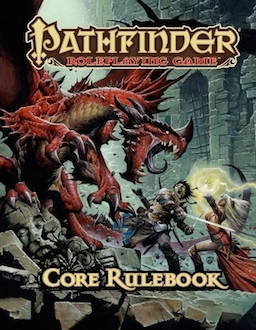
Solaas addresses this in his very first chapter, “Characters.” There are no Races but the “standard human” and the “Scandinavian” (the latter enjoy an increase in their Strength statistic). Even in — and perhaps especially — a human-centric game, this boost to Northerners is a problematic distinction from others, though we should not forget that all other humans are free to choose any single Characteristic to similarly increase; they’re also free to choose their bonus Feat at first level, whereas Scandinavians must take “Endurance.” Another necessity of adapting D&D to a Vikings setting is a reimagining of “Classes.” Solaas provides six to replace the six out of the 3.5 Core Book. Solaas’s are: Lightfoot, Priest, Seithman, Skald, Educated, and Viking. Lightfoots are sneaky and dexterous fighters little concerned with the traps that their true 3.5 analogues are. Priests and Seithmen are kind of like Clerics and Druids, respectively, though Solaas right away says that combat is important in this game and that “magic” is less effective overall, so that players building these classes should keep this in mind. Skalds are kind of like Sorcerers (I know, you might think “Bard,” but they cast spells alone — no bardic performances — but they have bonuses to knowing useful tales). Educated are kind of like Bards, too, because they are so skilled (perhaps more like the “Investigator,” for Pathfinder players), though Solaas likens them to “diplomats, navigators, scouts, and advisors,” and, unlike Bards (and Skalds), they don’t know magic. Without digging too deeply into numbers and concepts, the most problematic of these Classes might be the Viking. Solaas himself gives a bit of the guessed-at etymology of this word — that to go “viking” was “to sail to unknown shores, explore strange cultures and plunder their riches.” But, in game terms, Solaas likens the title to that of a “knight” and that these characters are expected to behave properly in front of “nobles and even royalty.” Hm, this characterization might be reflected in the Sagas, but, as a “Class,” I find it unsatisfying.
Two things I happily take away from this chapter, though, are Solaas’s words on “Alignment” in Viking campaigns and on the naming of Characters. Of Alignment, he says there is none, a sentiment that I’m sure is shared by many playing traditional D&D. Of the naming of Characters, he says, Characters are expected to “earn” their names, that, ideally, they should be named by others because of some distinguishing characteristic or feat that they have accomplished. Solaas offers some historical examples in
Eirik Bloodaxe (he never cleaned his axe), Halfdan the Black (black hair amongst so many blondes), and Gange Rolf (“Walking Rolf” was too big to ride any animals), to cite a few. It makes me start thinking about what kind of names I should be bestowing — in serious or in fun — on my players’ characters in my Yggdrasill campaign.
As I’ve suggested, a purpose in reading these Viking rpgs and supplements is to locate elements that might serve well in my current Yggdrasill game, to explore synergies, different perspectives, or aspects that might somehow be left out of my current game of choice. In reviewing this material, then, I will be reporting on 1. The quality and entertainment of the read itself, 2. The degree to which the game appears to succeed at emulating the atmosphere of a Viking rpg, 3. The new material or perspectives that the game material brings to the emulation of a Viking ethos, and 4. The question of whether or not I would like to play the game and, if not, what I would like to steal from it for my favored system. We have begun to answer this last question with Solaas’s comments on Viking naming.
There are some items of interest in Solaas’s “Skills and Feats” and “Equipment” chapters, but I’m going to move right on to his coverage of “Religion.” An exception to much of the same material in many a sourcebook is a lengthy discussion concerning “sacrifices,” breaking these offerings into three categories: Minor, Communal, and Greater. Is this going to inform my own campaign? Most certainly, particularly Solaas’s observations on Communal sacrifices, which detail aspects of a Norse festival. Is this talk gritty, bloody, and “pre-modern?” You bet! It only gets worse when Solaas moves on to discussing the “Bloody Eagle” (I knew enough about it, but I’m not sure if I read anywhere that, with some victims, their external lungs continued to inflate and deflate until they died).
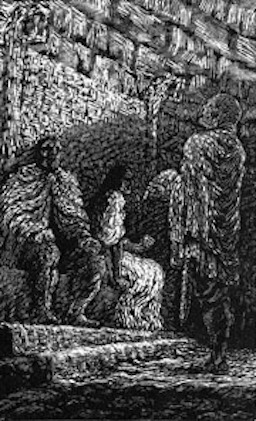
Chapter Five concerns the requisite “Prestige Classes,” and they are as unnecessary as always. Though here is where you will find your Viking-specific Berserker and Volva and (original for this endeavor) the “Spirit Smith.”
This last is an important Prestige Class because this is nearly the only way a character might obtain magical weapons and armor in this setting. Tucked away with a description of this Prestige Class is historical evidence of charred animal and human bones in Viking Age smithies! Yes, the Spirit Smith requires these grisly components for forging her magical equipment. Is this cool? Heck, yeah! Am I going to use it in my own game? We shall see. The Yggdrasill “canon” specifies that only Dvergar (Dwarves) have the ability to craft true magical items (though, as a storyteller, I have found myself already challenged by this requirement).
And this brings us neatly to Solaas’s interpretation of how magic works at all in his Viking Age and, specifically, in a D20 system. What I expect to discover as I survey these Norse-themed role playing games is that in matters of “reality” there more or less will be a consensus. Sure, there will be occasional disagreements in how to interpret the historical record or archaeological evidence, but I expect these disagreements to be minor and infrequent, particularly if the writer has conducted due diligence with his research and is aiming for an “authentic” (as opposed to, perhaps, a “cinematic”) representation of Viking culture. When it comes down to what is “not real,” though–magic, supernatural creatures, and, to some extent, the Gods–it becomes difficult to agree. The Norse culture obviously did not have a “system” to its magic, at least not one like the kinds of systems designed by the natural scientists during the Middle Ages, and certainly not anything remotely comparable to what we mean now when we say magic system in relation to role playing games. It is probably true that if Viking Age Northerners had magic systems at all, then they were diverse, sometimes contrasting, sometimes complementary, probably at once intuitive and counter-intuitive, and not passed down to the present generation through a medium or manner that is at all helpful to us or devoid of ambiguities.
One task for a fantasy role playing game designer is to take something that most moderns agree is “unreal” — that is true, functional magic–and to make it “real” within the context of a secondary world, to give it “rules” and mechanics, a “physics,” if you will, for its operation within the collaborative storytelling effort that is role playing. And when the real world sources or references to Viking Age magical belief are obscure, vague, puzzling, or even contradictory, game makers are liable to come up with interesting and various approaches to the “unreal.”
In making a Viking game that uses the D20 system, Solaas first had to wrestle with the concept of “Vancian” magic (magic that functions like the magic in many Jack Vance stories), a magic system that requires spell casters to spend an hour “memorizing” spells that are “forgotten” as soon as they are cast. This kind of magic evokes a very particular atmosphere or “flavor” in the secondary world (as most aspects of D&D do, from its Races and Classes to, most particularly, its Monsters and Traps). But how well does Vancian magic–so essential to the core rules of the D20 system–emulate or align with the little we know about Old Norse conceptions of magic? Very little. A first problem is that D20 spell casters have to study from a book to memorize their spells for the day. Viking Age people had very little experience with the concept of a book. In D20, “divine” spell casters memorize their spells after an hour of prayer or meditation. Is this a better analogue? Perhaps, perhaps not. Norse characters, if they were religious (in the way moderns understand religion) seem more likely to fear or to be intimidated by their Gods rather than to entreat them. And really, would their Gods answer their prayers with something so tangible and relevant as a spell of “Cure Light Wounds”, or aren’t they more liable to answer them cryptically, ironically, or even cruelly?
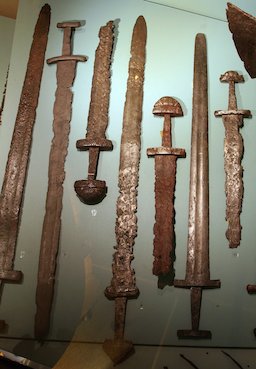
Right now you might be working out these questions for yourself and thereby moving towards creating or adapting a system of your own. But the subject before me now is what Solaas did with these questions, and I raise them here to illustrate the challenges that Solaas accepted when he decided to work within the D20 system.
Solaas appears to have first scoured the D20 spell lists and sorted away the spells appropriate for a Viking game. A result of this is that, on average, the power of the spells is greatly diminished (no Fireballs in these lists!). Solaas also has altered the X # spells per day system into a spell point system. This allows a player character to “buy” whatever spells of appropriate levels she would like to prepare for the day from her spell point budget. This still is Vancian magic, however, because magic users prepare their spells by scoring runes on stones or on a staff or wand, and these runes lose their potency when “completed” or cast. And yet Solaas introduces a new, Runic subsystem that allows characters, as long as they have spell prerequisites, to score runes on items for protracted magical effects. A new term for me, provided by Solaas, is “tul” as a Nordic spell caster. To slightly retread what has come before, there are roughly four types of tuls: Priests, Seithmen, Skalds, and Galderers. If you have read my review on my game of choice, you might remember that that system offers three types of magic — Seidr, Galdr, and Runes — which aren’t quite the same as “spell caster types.” But we see some of that here interestingly reconceived.
And perhaps rightly! Solaas provides some intriguing information. “Galderers,” he writes, “are jotun [giant] tuls, who practice an art of magic known as galdring. A galderer spell is called a galder. ‘To galder’ means ‘to crow’, like a rooster. This is because galderers deliver the verbal components of their spells as a sort of shouted song; they ‘sing’ them out as loud as they can.” This connection of galdr with giants I had not encountered before, certainly not in Yggdrasill (which aligns Galdr magic mostly with Skalds, probably because of the aural — and oral — aspect). I am not certain of Solaas’s basis for this distinction, but I find it fascinating, just as I find it interesting that he makes a “Volva” a Prestige Class and not an essential title as a practitioner of that magic, as Yggdrasill does. To conclude my observations of Solaas’s magic system, I’m not sure if these differences result from ambiguities with the folk source materials themselves or because of the D20 system, but they’re a joy to read!
For those looking for material for a historical campaign, Solaas’s chapter “From Trading to Raiding” is quite useful, particularly because Solaas gives profiles and historical overviews of a number of Viking cities and outposts. I detect a bit of historical revisionism here, though. I’m no scholar of history, but Solaas’s suggestion that a chief cause of Viking aggression is a response to Charlemagne’s expansionist Christian empire feels culturally motivated. In fact, Solaas goes so far as to suggest that the Vikings raided Lindisfarne in 793 as an intentioned, symbolic strike on Christianity, that they somehow knew that Lindisfarne was Charlemagne’s religious advisor Alcuin’s “home turf,” and that such an attack therefore directly would send to Charlemagne the message,
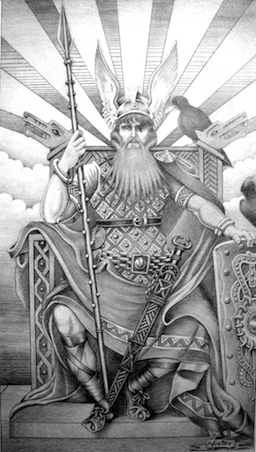
“This is what happens if you try to mess with Scandinavia!” Solaas even seems to justify Viking brutality, claiming that Vikings were no worse than Christian knights–perhaps Vikings even were better than medieval Christians because, as Solaas says, “they don’t make a habit of torturing prisoners and leaving people crippled,” a puzzling claim when one remembers Solaas’s detailed description of the Bloody Eagle.
Further setting chapters informed me of three historical dice and board games Vikings played. They also detailed the landscapes of Norway, Sweden, and Denmark, which is really helpful for me in trying to visualize these landforms’ analogues in Yggdrasill. But is all of this enough to justify my purchase of the game?
Well, let’s answer my four review questions, and we shall find out.
First, is the read quality and entertaining? Yes! This is a very neat and professional production, as long as one is not irritated by the typos and consistent misspellings that probably result from a writer more used to working in another language (“loose” for “lose” and “doze” for “dose” are two examples of many consistent spelling errors). It is an entertaining read, as well, particularly if you are familiar with traditional D&D systems and the D20 system in particular. Watching Solaas adapt that rules set to his vision is fascinating.
Second, how successfully does the game appear to emulate the Viking Age? It might do so well, though I have a suspicion that, outside of theory and into practice, the limitations of the D20 system for a specific game like this will reveal themselves.
Third, what new material or perspectives does this bring to the Viking ethos? A lot of the “new” material or perspectives on Norse culture I’ve exposed throughout the midst of this review, and I most certainly am going to steal it, specifically many items from Solaas’s “Monsters” chapter. In this section, many of these creatures’ names are shared with beings in the Pathfinder Bestiaries I already own, but most of the Pathfinder analogues are imperfect representations of “genuine” Norse-flavored creatures. Solaas does a much better job of evoking a Norse beastie, and his palette is wider than what my preferred game has offered me. So thank you, Vidar Solaas!
But, fourth, do I want to play the game? I’m afraid not. Pathfinder to level 11 has been enough for me, thank you! But maybe after a lengthy recovery period I’d be more amenable. Skol!
Just wanted to repeat Zhern’s comment from my last post that Bundle of Holding currently is offering the entire Yggdrasill line (and others) for a steal and for charity. I couldn’t resist, and first impressions of Qin are beautiful! https://bundleofholding.com/presents/Cubicle7
I’m really intrigued by Qin also! I haven’t had a chance to read through your post yet but will do later today.
Patrick/Zhern
Gabe – Curious if you’ve read through the Northlands Saga (which is something like 800 pages or so, as I recall)?
Bob, I bought it direct from Bill Webb at Gamehole Con. I’ve read the preview adventures so far and have been very impressed and entertained. I think I remember you saying something about the demon cult plots being too traditional fantasy in flavor and slightly off for a specific Norse campaign, and I agree. I expect a full review of it when I’m done.
Like you, I’m becoming more and more enamored of Frog God products: I really like their tone and design! Next time I run a traditional fantasy rpg, I’m pushing my group to this system!
Back when they were putting out the individual modules (instead of a mega-campaign), I did comment that the first two felt more like American eskimo-type of things.
But starting with the third one, they shifted to Viking mode it had that tone moving forward. I still need to read the last few adventures.
Northlands Saga is excellent. I’ve only read it but am hoping to run it for my group at some point in the future. As far as FGG products go, you would be hard pressed to find a sub-par offering from them. They are very good at what they do.
Hey Zhern – email me about Frog God when you get a chance: upabob@yahoo.com